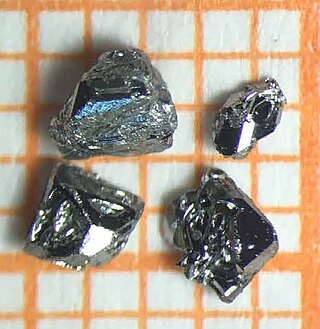Intermetallic
Type of metallic alloy From Wikipedia, the free encyclopedia
An intermetallic (also called intermetallic compound, intermetallic alloy, ordered intermetallic alloy, long-range-ordered alloy) is a type of metallic alloy that forms an ordered solid-state compound between two or more metallic elements. Intermetallics are generally hard and brittle, with good high-temperature mechanical properties.[1][2][3] They can be classified as stoichiometric or nonstoichiometic.[1]

Cr11Ge19
The term "intermetallic compounds" applied to solid phases has long been in use. However, Hume-Rothery argued that it misleads, suggesting a fixed stoichiometry and a clear decomposition into species.[4]
Definitions
Summarize
Perspective
Research definition
In 1967 Gustav Ernst Robert Schulze defined intermetallic compounds as solid phases containing two or more metallic elements, with optionally one or more non-metallic elements, whose crystal structure differs from that of the other constituents.[5] This definition includes:
- Electron (or Hume-Rothery) compounds
- Size packing phases. e.g. Laves phases, Frank–Kasper phases and Nowotny phases
- Zintl phases
The definition of metal includes:[citation needed]
- Post-transition metals, i.e. aluminium, gallium, indium, thallium, tin, lead, and bismuth.
- Metalloids, e.g. silicon, germanium, arsenic, antimony and tellurium.
Homogeneous and heterogeneous solid solutions of metals, and interstitial compounds such as carbides and nitrides are excluded under this definition. However, interstitial intermetallic compounds are included, as are alloys of intermetallic compounds with a metal.[citation needed]
Common use
In common use, the research definition, including post-transition metals and metalloids, is extended to include compounds such as cementite, Fe3C. These compounds, sometimes termed interstitial compounds, can be stoichiometric, and share properties with the above intermetallic compounds.[citation needed]
Complexes
The term intermetallic is used[6] to describe compounds involving two or more metals such as the cyclopentadienyl complex Cp6Ni2Zn4.
B2
A B2 intermetallic compound has equal numbers of atoms of two metals such as aluminum and iron, arranged as two interpenetrating simple cubic lattices of the component metals.[7]
Properties
Summarize
Perspective
Intermetallic compounds are generally brittle at room temperature and have high melting points. Cleavage or intergranular fracture modes are typical of intermetallics due to limited independent slip systems required for plastic deformation. However, some intermetallics have ductile fracture modes such as Nb–15Al–40Ti. Others can exhibit improved ductility by alloying with other elements to increase grain boundary cohesion. Alloying of other materials such as boron to improve grain boundary cohesion can improve ductility.[8] They may offer a compromise between ceramic and metallic properties when hardness and/or resistance to high temperatures is important enough to sacrifice some toughness and ease of processing. They can display desirable magnetic and chemical properties, due to their strong internal order and mixed (metallic and covalent/ionic) bonding, respectively. Intermetallics have given rise to various novel materials developments.[citation needed]
| Intermetallic Compound | Melting Temperature
(°C) |
Density
(kg/m3) |
Young's Modulus (GPa) |
|---|---|---|---|
| FeAl | 1250–1400 | 5600 | 263 |
| Ti3Al | 1600 | 4200 | 210 |
| MoSi2 | 2020 | 6310 | 430 |
Applications
Summarize
Perspective
Examples include alnico and the hydrogen storage materials in nickel metal hydride batteries. Ni3Al, which is the hardening phase in the familiar nickel-base super alloys, and the various titanium aluminides have attracted interest for turbine blade applications, while the latter is also used in small quantities for grain refinement of titanium alloys. Silicides, intermetallics involving silicon, serve as barrier and contact layers in microelectronics.[9] Others include:
- Magnetic materials e.g. alnico, sendust, Permendur, FeCo, Terfenol-D
- Superconductors e.g. A15 phases, niobium-tin
- Hydrogen storage e.g. AB5 compounds (nickel metal hydride batteries)
- Shape memory alloys e.g. Cu-Al-Ni (alloys of Cu3Al and nickel), Nitinol (NiTi)
- Coating materials e.g. NiAl
- High-temperature structural materials e.g. nickel aluminide, Ni3Al
- Dental amalgams, which are alloys of intermetallics Ag3Sn and Cu3Sn
- Gate contact/ barrier layer for microelectronics e.g. TiSi2[10]: 692
- Laves phases (AB2), e.g., MgCu2, MgZn2 and MgNi2.
The unintended formation of intermetallics can cause problems. For example, intermetallics of gold and aluminium can be a significant cause of wire bond failures in semiconductor devices and other microelectronics devices. The management of intermetallics is a major issue in the reliability of solder joints between electronic components.[citation needed]
Intermetallic particles
Intermetallic particles often form during solidification of metallic alloys, and can be used as a dispersion strengthening mechanism.[1]
History
Examples of intermetallics through history include:
- Roman yellow brass, CuZn
- Chinese high tin bronze, Cu31Sn8
- Type metal, SbSn
- Chinese white copper, CuNi [11]
German type metal is described as breaking like glass, without bending, softer than copper, but more fusible than lead.[12]: 454 The chemical formula does not agree with the one above; however, the properties match with an intermetallic compound or an alloy of one.[citation needed]
See also
References
Sources
External links
Wikiwand - on
Seamless Wikipedia browsing. On steroids.
